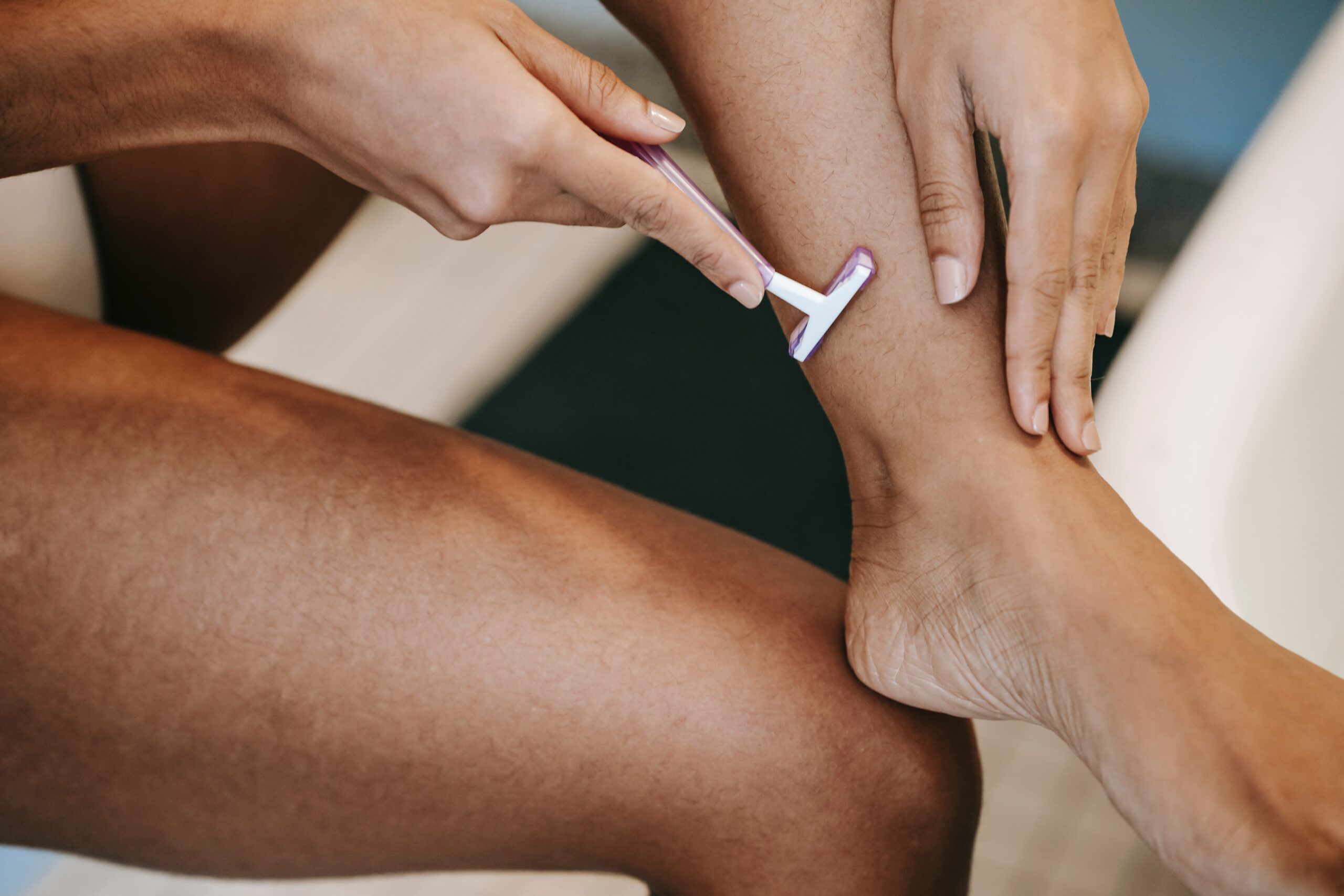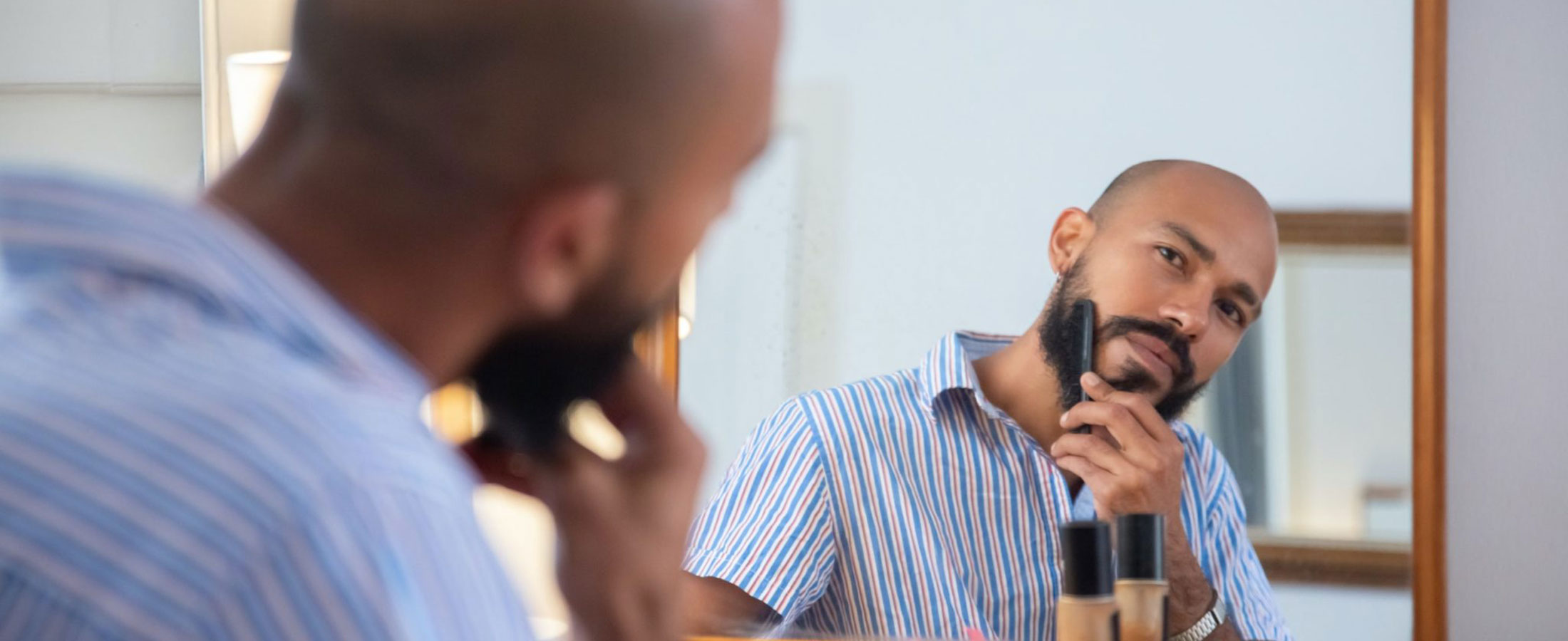Have you ever noticed a rash on your legs after shaving? If so, it could have been razor bumps. So, what do razor bumps look like on the legs?
Razor bumps on the legs look like small pimples or ingrown hairs. It is important to differentiate between razor bumps and bumps that appear after shaving. Razor bumps is a true medical condition formally known as pseudofolliculitis barbae. Bumps that show up as a rash on the legs after shaving could be something else. What some people refer to as razor bumps, actually aren't.
There are also a few other bumpy skin conditions associated with shaving. Razor bumps are more common in some parts of the body and certain skin types. If you see something that looks like razor bumps, here’s what you need to know.

Shaving often irritates the skin. As a result, it can cause problems, such as razor bumps. Razor bumps on the legs might look pink or red. And they are often swollen.
The medical term for razor bumps is pseudofolliculitis barbae. In particular, it is caused by hairs cut by a razor with a pointy or jagged edge, like a tiny knife. Sometimes, these short, coarse, curly hairs curl and grow back into the skin. In other words, razor bumps are a type of ingrown hair. Only a medical professional licensed to diagnose and treat conditions can tell for sure if it's razor bumps.
Razor bumps usually appear 24-48 hours after shaving. The good news is that razor bumps typically do not appear on the legs. Razor bumps usually cause ingrown hairs on the face and neck for two reasons:
An exception, though, is the upper thigh and groin area. This area is more likely to be affected by true razor bumps. That is because hairs in these regions are likely to be thicker and wavy or curly.
Bumps on the legs after shaving that are not located in the thigh or groin area are probably not razor bumps. They could be another skin condition.
Bumps on the lower legs after shaving might be razor burn. Razor burn is another type of rash that looks like small red bumps. But it is not caused by ingrown hairs. So, it usually shows up in only a few hours after shaving.
Razor burn is usually not as serious as razor bumps and resolves on its own quickly. It is caused by skin irritation related to the razor, shaving products, or just the shaving method. While it causes a burning sensation and looks bad, it usually won’t cause any long-term damage.
Another reason you might have bumps on your legs after shaving is an irritation caused by the razor or the shaving cream. Skin sensitivities can show up as a rash. topics/sensitive-skin" rel="noreferrer noopener">Itching is a good sign that someone might have skin sensitivity.
Folliculitis is another condition that could cause bumps on the legs after shaving. A hair follicle is a pocket in the skin where the hair root grows. Folliculitis is an inflamed, irritated, or infected hair follicle.
Sometimes the skin pocket or hair follicle is injured through shaving. When bacteria enter the hair follicle, it can cause infection.
Folliculitis, skin sensitivities, and razor burn are three conditions that might look like razor bumps. People often refer to them as razor bumps because they cause spots on the skin, usually after shaving. But each condition has a different cause, so they are treated differently.
So how can you tell what the rash on your leg is?
These are four skin problems that commonly appear on the legs. If you noticed bumps from shaving on your legs and are unsure if you have razor bumps or something else, talk to a doctor about it. A virtual physician can look at your skin through a secure video visit and make recommendations to help you treat the problem. They can help you clear up your skin in no time, and you can say goodbye to unattractive bumps on your legs.
Have you experienced problems from shaving for your job? If razor bumps have you worried, you need to talk to one of our doctors. Meet a top board-certified physician online through a convenient virtual video visit. Find out more by chatting with us now.
Disclaimer: The contents of this article are for informational purposes only and do not constitute medical advice. The information, graphics, and images on this site are not intended to substitute diagnosis or treatment by a medical professional. Always seek the advice of a licensed physician for any questions you may have regarding a specific condition.

Pseudofolliculitis barbae is a common skin condition that many adults will face at some point in their lives. With so many people affected, you might wonder how it is diagnosed.
Pseudofolliculitis barbae is typically diagnosed by physical examination by a licensed healthcare provider, such as a doctor or advanced nurse practitioner. Medical tests, including studying skin tissue samples under a microscope in a laboratory, may also aid in the physician’s diagnosis.
So how does a doctor examine pseudofolliculitis barbae? And how can someone find a physician to treat this problem? Read on to find out.
Want to speak to a board certified physician? Book an appointment today!
Anyone who shaves is at risk of developing "shave bumps," "razor bumps," or ingrown hairs. But African American men are affected most. Studies show that todate.com/contents/pseudofolliculitis-barbae#H87492034">between 45% and 83% of African American men who shave will develop pseudofolliculitis barbae. Men of other ethnicities and women too can experience this problem. It most often appears in the face but can also show up under the arms, in the bikini area, or the legs.
Physicians or practitioners can diagnose pseudofolliculitis barbae tologic-disorders/hair-disorders/pseudofolliculitis-barbae#v38068013">by physical examination at a simple doctor's visit. With any physician encounter, the first part of the diagnosis will be an interview.
The doctor will ask the patient questions to figure out what is wrong or what the complaint is. Some common questions a provider might ask when diagnosing pseudofolliculitis barbae are:
In addition to taking a history, the doctor will observe the skin for any changes. Small red to-avoid-bikini-line-bumps-2/">bumps, tenderness, and itching are all signs that could alert the doctor to a possible diagnosis of pseudofolliculitis barbae.
Finding a doctor for pseudofolliculitis barbae is easier than ever. A dermatology or skin specialist referral may not be necessary. Many primary care doctors can diagnose and treat this problem with a quick check-up.
There is also good news for patients who do not have a doctor. When someone doesn't have a doctor or is unsure how to find one, a virtual physician is a great option. Online doctor visits are often less expensive than going to a doctor's office. And in many cases, patients can book them faster. Most virtual physicians offer convenient appointment times, and some even have same-day bookings.
Whether online or in-person, it is best to contact the doctor and ask for an appointment to evaluate a skin condition. Give the doctor as much information as possible. If you think it's pseudofolliculitis barbae, then let the provider know when you book your visit.
A licensed healthcare provider is the only one who can say for sure if a skin rash might be a case of pseudofolliculitis barbae or something more serious. Luckily, an appointment to see a physician can be simple and inexpensive. Relief may be as close as a phone call or video visit today.
Our caring experts can help answer your skin questions. To meet a top board-certified physician, book an appointment today.

A shaving waiver is a type of medical release or exemption form. Men who have skin conditions may need this form for work.
Shaving waivers are also called “no-shave waivers.” They are for men with certain skin conditions. Sometimes shaving causes serious skin problems. A medical doctor can complete this release to show why a man should not be required to shave his face.
Why would an individual need a shaving waiver, and where can you get one?
The shaving waiver shows employers and supervisors of organizations that it would be unhealthy for a man to shave. A shaving waiver must be necessary to prove that an individual should not have to shave for medical reasons.
For some men, facial shaving causes:
According to to-dictate-the-terms-of-m/" rel="noreferrer noopener">Kennard Law P.C., “from a legal perspective, employers may require male employees to shave as long as it does not infringe on their civil rights or cause undue hardship.” For this reason, it may be necessary to show proof that shaving creates a problem for the individual.
Speak to a virtual doctor today about a shaving waiver!
Some men in sales or marketing, law enforcement, or sports may be required to shave their faces. Other jobs that require men to be clean-shaven include those where employees may be exposed to fire or hazardous chemicals and would be required to wear respirator equipment.
In the military, this waiver is also called a military shaving profile. The Department of Defense expects its male members to maintain zero visible facial hair, other than a neatly maintained mustache, when in uniform. This requirement stems from the five elements of dress and personal appearance: neatness, cleanliness, safety, uniformity, and military image.
In some cases, when shaving causes serious health concerns to the individual, this medical form may be necessary.
Do you need a shaving waiver? You can schedule a virtual doctor visit with one of our board-certified physicians about a shaving waiver.
We are now offering evening and weekend appointments. My Virtual Physician treats skin conditions and much more. Our caring experts provide telemedicine services for your healthcare needs, all from the convenience of your home.
If you have suggestions for other topics you want to read about, let us know! Don’t forget to follow us on social media.

Many women enjoy the feel of soft-shaven skin. But the red, itchy patches that come after can be a real pain. Razor bumps in sensitive areas like the bikini line are annoying. So how can men and women deal with razor bumps down there?
Razor bumps, technically called pseudofolliculitis barbae, are a common skin complaint. Fortunately, they are preventable to some degree. By protecting skin before, during, and after hair removal, men and women can minimize the effects of razor bumps.
If you're wondering how to save your skin, check out these tips to steer clear of painful razor bumps.

Razor bumps are an uncomfortable sign of skin irritation. For those who already have them, the first step is to keep them from getting worse.
A compress made with salt water can also help soothe the skin. Saltwater cleans and heals the skin by osmosis. To make a "saline soak" at home:
Consider adding a couple of drops of an essential oil, like tea tree oil, to the saline solution for more relief.
When bumps don't go away or become more painful, it may be best to see a doctor.
A physician can tell if the problem is razor bumps or may be something else. Some doctors use antibiotic gels, steroids, or retinoids to treat severe cases.
They say an ounce of prevention is worth a pound of cure. When it comes to razor bumps, it's very true.
Here's how you can lower your risk of getting razor bumps from shaving.
Find more tips on how to prevent razor bumps here.

Taking care of skin before, during, and after hair removal can go a long way in preventing razor bumps.
If you've tried to treat pseudofolliculitis barbae yourself but find the situation getting worse, it may be time to check with a doctor.
Are you looking for a doctor near you to treat your sensitive issues? My Virtual Physician has board-certified physicians who can address gynecological and primary care problems via video visits.
If you would like to talk with a board-certified doctor, you can schedule your appointment online now. My Virtual Physician offers health screening, lab tests, and counseling to meet all of your healthcare needs.

Masks have become a permanent accessory for many U.S. workers. Unfortunately, facial hair makes masking difficult. Some workers required to wear personal protective equipment, like respirator masks, find it especially hard. You may even wonder, how can men with full beards wear N95 masks?
An N95 respirator mask is a protective device made to fit tightly against the face to filter 95% of particles from the air entering the nose and mouth. As a result, men with full beards cannot wear N95 masks safely or effectively. Facial hair that comes between the skin and mask edges prevents a tight fit and good seal.
So what can men do if they have facial hair but need respiratory protection? There are options for men in such situations. Read on to find out.
Many jobs require respiratory protection. Here are just a few of the workers that may be required to wear an N95 mask in on-the-job situations.
In many of these jobs, facial hair is not allowed. Therefore, tory?id=69916196" target="_blank" rel="noreferrer noopener">some men choose to shave their facial hair.
Unfortunately for some of these workers, going clean-shaven causes problems. Sometimes shaving causes adverse effects.
The face and neck are sensitive parts of the body. Facial shaving may result in some very uncomfortable skin conditions. Problems created by shaving may include folliculitis, painful skin infections, and hyperpigmentation. For men suffering from significant health conditions like these, limiting or even avoiding shaving may be necessary.
A shaving waiver, also known as a shaving profile or “no-shave waiver,” can help individuals with certain conditions. A shaving profile is a medical release or exemption form. The document, completed by a physician, explains why a man should not be required to shave his face due to health concerns.
Shaving waivers allow men to forgo shaving and get the right respiratory protection for them. Men with facial hair do not have to risk inhaling unsafe vapors.
Some respirator masks do not require a face seal. These types are a better option for bearded employees.
Specifically, positive-pressure respirators worn over facial hair or beards work to filter the air. A hood-and-helmet type mask uses continuous airflow to protect employees.
One example that is available to workers is called the Powered Air Purifying Respirator (PAPR) mask. This loose-fitting respirator uses a blower to pass air through a filter before sending it to the face. Typically, PAPR masks are lightweight and battery-operated. Also, PAPR masks do not require Fit-Testing.
One drawback is their cost. Most employees would not want to invest in their own PAPR. Those looking for a PAPR respirator can purchase a simple version online for around $100. However, some are upwards of $1000. Batteries and chargers may double the expense.
Although these masks are more costly, they offer superior protection. According to tomerics/" target="_blank" rel="noreferrer noopener">this article by the Center for Disease Control and Prevention (CDC), a PAPR mask may offer an Assigned Protection Factor (APF) of 1000, where an N95 respirator only has an APF of 10. The higher the protection factor, the safer it is.
The use of a PAPR mask does require a physician’s medical evaluation. It is a respirator, and therefore OSHA’s requirements to evaluate an employee before requiring the mask applies to this type.
Men with full beards can find respiratory protection that won’t cause health problems or skin conditions. The first step is a medical evaluation by a licensed physician.
Men interested in finding out if a PAPR mask or shaving waiver for their employer would be right for them should talk to a doctor.
My Virtual Physician now offers consultations for shaving waivers in some states. Fill out the contact form below to speak to one of our board-certified physicians about a shaving waiver.